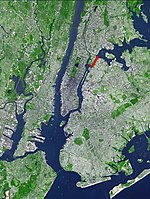Charles Poletti Power Project

The Charles Poletti Power Project was a power station located in northeastern Queens, named after politician Charles Poletti. An 885-megawatt oil and natural gas-fired facility originally known as Astoria 6, it started generating electricity in 1977, and was gradually phased out starting in 2002, replaced by a newer, cleaner facility on the same site in 2005, Astoria Energy. The plant was shuttered in 2010 following a lawsuit and years of community opposition. It was one of the dirtiest power plants in the state while it was operating, and pollution from the plant was said to contribute to high rates of asthma in the surrounding neighborhood of Astoria, giving it the nickname "Asthma Alley". In 2021, New York State approved a plan to build a 100-megawatt battery system, the East River Storage System, on the site, in order to store and discharge renewable energy.
Excerpt from the Wikipedia article Charles Poletti Power Project (License: CC BY-SA 3.0, Authors, Images).Charles Poletti Power Project
Shore Road, New York Queens County
Geographical coordinates (GPS) Address Nearby Places Show on map
Geographical coordinates (GPS)
| Latitude | Longitude |
|---|---|
| N 40.7877 ° | E -73.9129 ° |
Address
Shore Road
11105 New York, Queens County
New York, United States
Open on Google Maps









